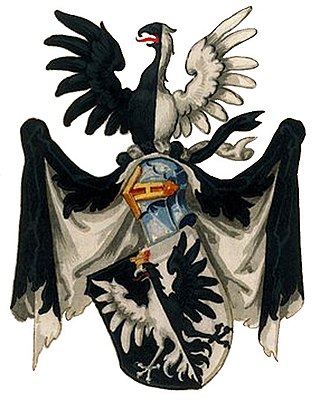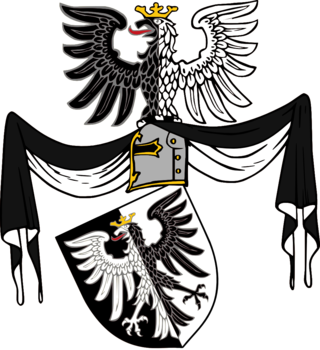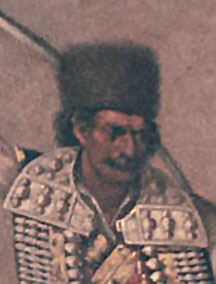This article is written like a story.(April 2020) |

The Martinovitch-Orlovitch family is a noble family originating in the medieval Serbia.
This article is written like a story.(April 2020) |

The Martinovitch-Orlovitch family is a noble family originating in the medieval Serbia.
They are descendants of the ancient Orlovitch family and one of Serbia's great heroes, Paul Orlovitch, the Serbian flag-bearer at the Battle of Kosovo in 1389. [1] One of the most famous members of this family was Obren Martinovitch who led the Serbian uprising against the Ottoman Empire and started the Obrenovitch dynasty that would rule Serbia until their assassination by the Black Hand and replacement by the Karageorgevitch family. [2] Through marriage of Anastasia Martinovitch-Orlovitch (1824-1895) into the Montenegrin royal family, Martinovitch-Orlovitch blood can be found in the royal families of Montenegro, Serbia, Russia, and Italy. [3]
Though the use of titles of nobility (in the traditional sense) in the Balkans is somewhat disputed, the members of the family carry the title of voyévode (vojvoda, loosely translated as duke), though several members had carried the title of knez (loosely translated as prince) and others tied to their functions under the Ottoman regime. Just like the other descendants of the Orlovitch family, the Martinovitch have an eagle in their crest and Saint John the Baptist as their patron saint. [4]

Due to a later stabilisation of family names in the Balkans compared to the rest of Europe, most of the members of the Martinovitch-Orlovitch family do not actually carry that last name. The family is composed of the following branches: [5] [6]
Through common Orlovitch ancestry, they are related to the Samardžić, Osmanagić or Čengić family, but also to Nikola Tesla (disputed). [7]

Požarevac is a city and the administrative centre of the Braničevo District in eastern Serbia. It is located between three rivers: Danube, Great Morava and Mlava and below the hill Čačalica (208m). As of 2022, the city has a population of 51,271 while the city administrative area has 68,648 inhabitants.

The House of Obrenović or Obrenović Dynasty was a Serbian dynasty that ruled Serbia from 1815 to 1842, and again from 1858 to 1903.

The Kingdom of Serbia was a country located in the Balkans which was created when the ruler of the Principality of Serbia, Milan I, was proclaimed king in 1882. Since 1817, the Principality was ruled by the Obrenović dynasty. The Principality, under the suzerainty of the Ottoman Empire, de facto achieved full independence when the very last Ottoman troops left Belgrade in 1867. The Congress of Berlin in 1878 recognized the formal independence of the Principality of Serbia, and in its composition Nišava, Pirot, Toplica and Vranje districts entered the South part of Serbia.

Nevesinje is a town and municipality in Republika Srpska, Bosnia and Herzegovina. As of 2013, the town has a population of 5,162 inhabitants, while the municipality has 12,961 inhabitants.

Ivan Crnojević was the lord of Zeta and Serbian leader from 1465 to 1490. Having formed an alliance with the Republic of Venice, he led the Serb resistance against the expanding Ottoman Empire He was successful at first but lost his realm in 1479. He resumed power in 1481 in Žabljak and soon founded Cetinje as the new capital of his state.

Pavle Orlović is a semi-mythological hero of the Kosovo cycle of Serbian epic poetry; he was a Serbian knight, one of the military commanders under Prince Lazar that fell at the Battle of Kosovo (1389) against the Ottoman Empire. According to folklore, Orlović was the son of voivode Vuk Orle, the Lord of Soko Grad on the Drina. After the death of Stephen Uroš V the Weak, Orlović held the mining town of Novo Brdo, as well as his father's possessions on Mount Rudnik in central Serbia.
Dušan T. Bataković was a Serbian historian and diplomat. His specialty was modern and contemporary Serbian and Balkan history as well as French-Serbian relations. The last post he held was that of Director of the Institute for Balkan Studies at the Serbian Academy of Sciences and Arts.

Herzegovina is the southern and smaller of two main geographical regions of Bosnia and Herzegovina, the other being Bosnia. It has never had strictly defined geographical, cultural or historical borders, nor has it ever been defined as an administrative whole in the geopolitical and economic subdivision of Bosnia and Herzegovina.
Turks in Serbia, also referred to as Turkish Serbians and Serbian Turks, are people of Turkish ancestry present in Serbia. Turks have lived on this territory since the Ottoman period. The Turkish minority has traditionally lived in the urban areas of Serbia together with many Muslim Albanians; however, in 1830, when the Principality of Serbia was granted autonomy, most Turks emigrated as "muhacirs" (refugees) to Ottoman Turkey, and by 1862 almost all of the remaining Turks left Central Serbia, including 3,000 from Belgrade. According to the 2011 census only 647 people declared themselves as Turks, though this does not include the Turkish minority in Kosovo.

The Orlović are a noble house originating in medieval Serbia.

The Kingdom of Serbia was one of the major parties in the two Balkan Wars, gaining land in both conflicts. It experienced significant territorial gains in the Central Balkans, nearly doubling its territory.

Stefan Konstantin was the King of Serbia from 29 October 1321 to the spring of 1322. The younger son of King Stefan Milutin (1253–1321), he initially held the appanage of Zeta, and was the heir to the Serbian throne after his father had exiled his elder brother Stefan. After his father's death, a throne struggle broke out between Konstantin, Stefan and their cousin Vladislav II, evolving into the two years long civil war. He was killed in the battle fighting his brother, who went on to defeat Vladislav, too, and gained the Serbian throne as Stefan Uroš III, better known as Stefan Dečanski.

Muzika na struju is the fifth studio album from Serbian and former Yugoslav rock band Bajaga i Instruktori, released in 1993.

Bajo Pivljanin, born Dragojlo Nikolić, was a Montenegrin and Serbian hajduk commander mostly active in the Ottoman territories of Herzegovina and southern Dalmatia. Born in Piva, a Serbian Herzegovinian tribe, at the time part of the Ottoman Empire, he was an oxen trader who allegedly left his village after experiencing Ottoman injustice. Mentioned in 1654 as a brigand during the Venetian–Ottoman war, he entered the service of the Republic of Venice in 1656. The hajduks were used to protect Venetian Dalmatia. He remained a low-rank hajduk for the following decade, participating in some notable operations such as the raid on Trebinje. Between 1665 and 1668 he quickly rose through the ranks to the level of harambaša. After the war, which ended unfavourably for the Venetians, the hajduks were moved out of their haven in the Bay of Kotor under Ottoman pressure. Between 1671 and 1684 Pivljanin, along with other hajduks and their families, were refugees in Dalmatia. Upon renewed conflict, he was returned to the Bay of Kotor and placed in charge of defending the frontier; in 1685 he and his band fell in battle against the advancing Ottoman governor of Scutari. Regarded as one of the most distinguished hajduks of his time, he is praised in Serbian epic poetry.

The Serbian–Ottoman Wars, also known as the Serbian–Turkish Wars or Serbian Wars for Independence, were two consequent wars, fought between the Principality of Serbia and the Ottoman Empire. In conjunction with the Principality of Montenegro, Serbia declared war on the Ottoman Empire on 30 June 1876. By the intervention of major European powers, ceasefire was concluded in autumn, and the Constantinople Conference was organized. Peace was signed on 28 February 1877 on the basis of status quo ante bellum. After a brief period of formal peace, Serbia declared war on the Ottoman Empire on 11 December 1877. Renewed hostilities lasted until February 1878.
Radovan Samardžić was a Yugoslav and Serbian historian, member of the Serbian Academy of Sciences and Arts (SANU).

The Rovčani are a historical tribe of Montenegro and one of the seven highlander tribes of the Brda region, alongside the Bjelopavlići, Piperi, Kuči, Bratonožići, Moračani and Vasojevići. The historical region that they inhabit is called Rovca.

The Serb uprising of 1596–1597, also known as the Herzegovina uprising of 1596–1597, was a rebellion organized by Serbian Patriarch Jovan Kantul and led by Grdan, the vojvoda ("duke") of Nikšić against the Ottomans in the Sanjak of Herzegovina and Montenegro Vilayet, during the Long Turkish War (1593–1606). The uprising broke out in the aftermath of the failed Banat Uprising in 1594 and the burning of Saint Sava's relics on 27 April 1595; it included the tribes of Bjelopavlići, Drobnjaci, Nikšić, and Piva. The rebels, defeated at the field of Gacko in 1597, were forced to capitulate due to a lack of foreign support.
{{cite book}}: CS1 maint: location missing publisher (link){{cite web}}: |last= has generic name (help)In the Almanach, she is listed simply as Anastasia Martinovitch.